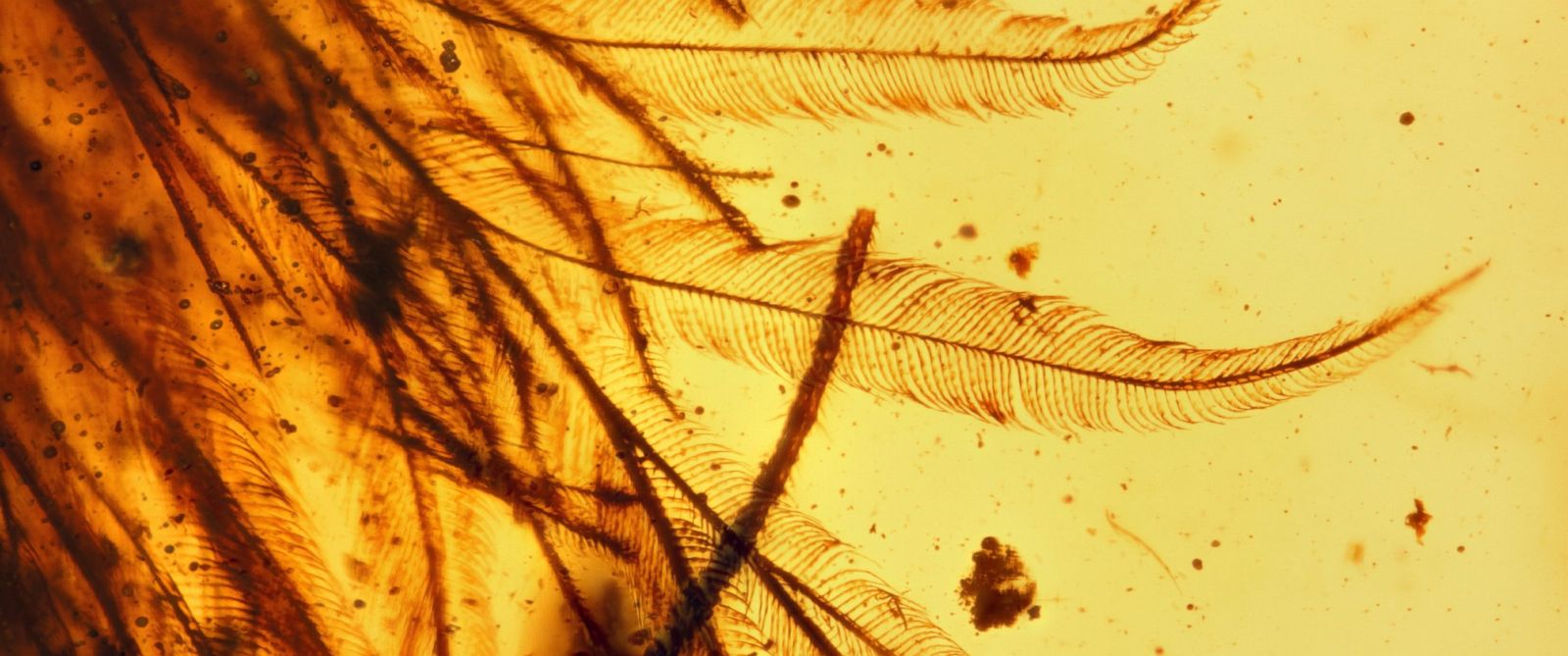| | | Discovery of Dinosaur Tail Encased in Amber Sheds Light on Evolution of Feathers
By AVIANNE TAN
Close
Follow on Twitter
More from Avianne
Dec 9, 2016, 3:39 PM ET
Share
Email
Star
 PlayROYAL SASKATCHEWAN MUSEUM (RSM/ R.C. MCKELLAR) PlayROYAL SASKATCHEWAN MUSEUM (RSM/ R.C. MCKELLAR)
WATCH Scientists Discover Link Between Feathers and Dinosaurs
Share
Email
A dinosaur tail preserved in amber has been discovered for the first time ever, researchers announced on Thursday in a paper published in the scientific journal Cell Biology.
The feather-covered tail is from a dinosaur that lived on Earth about 99 million years ago, according to a news release from Cell Press, which publishes Cell Biology.
 Chung-tat Cheung Chung-tat Cheung
This reconstruction image shows a small coelurosaur approaching a resin-coated branch on the forest floor.
Lida Xing, the paper's lead author and lecturer at the China University of Geosciences in Beijing, chanced upon the "remarkable specimen" while perusing an amber market in Myitkyina, Myanmar, in 2015, Cell Press said.
The dinosaur tail originally could have just ended up "a curiosity or piece of jewelry," Cell Press said, "but Xing recognized its potential scientific importance and suggested that the Dexu Institute of Palaeontology buy the specimen."
The Art of Deciding What Color Dinosaurs Are Is Part Paleontology, Part Palette-ontology
Rare 'Baby Dragons' Recorded Hatching in Ancient Slovenian Cave
Michigan Farmer Unearths Bones of Rare Mammoth Hybrid From Nearly 15,000 Years Ago
The finding has helped provide significant insight into dinosaurs' feather structure and evolution, which can't be determined from fossil evidence, according to Cell Press.
<img width="640" height="480" alt="PHOTO: This image released by the Royal Saskatchewan Museum in Canada shows a dinosaur tail complete with its feathers trapped in a piece of amber. " /> Royal Saskatchewan Museum (RSM/ R.C. McKellar)/AFP/Getty Images
This image released by the Royal Saskatchewan Museum in Canada shows a dinosaur tail complete with its feathers trapped in a piece of amber.
more +
"Amber pieces preserve tiny snapshots of ancient ecosystems, but they record microscopic details, three-dimensional arrangements and labile tissues that are difficult to study in other settings," said Ryan McKellar, co-author of the paper and curator of invertebrate paleontology at the Royal Saskatchewan Museum in Canada.
Researchers have been using CT scanning and microscopic observations to get a closer look at the feathers, Cell Press said. The scientific journal publisher noted that hemoglobin, a protein in red blood cells that carries oxygen, was found in the amber.
Researchers said they are now "eager to see how additional finds from this region will reshape our understanding of plumage and soft tissues in dinosaurs and other vertebrates," Cell Press added. |
|





 PlayROYAL SASKATCHEWAN MUSEUM (RSM/ R.C. MCKELLAR)
PlayROYAL SASKATCHEWAN MUSEUM (RSM/ R.C. MCKELLAR) Chung-tat Cheung
Chung-tat Cheung